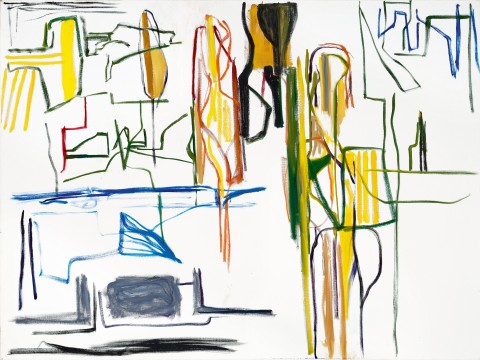WATER AND LIGHT, 1999
KEN WHISSON
oil on canvas
90.0 x 119.5 cm
signed, dated and inscribed with title verso: 7/2/99 Title: “Water and Light” / or / “Seaside with / Green Lines and Black Boat”/ … / Ken Whisson / Perugia 7/2/99 /
Watters Gallery, Sydney (label attached verso)
Private collection, Sydney
Deutscher~Menzies, Melbourne, 1 May 2002, lot 97
The Cbus Collection of Australian Art, Melbourne, acquired from the above
Ken Whisson Landscape Paintings, Watters Gallery, Sydney, 20 October – 6 November 1999, cat. 11 (illus. in exhibition catalogue)
Essential, Latrobe Regional Gallery, Victoria, 8 May - 5 September 2010
Mute Reason, Latrobe Regional Gallery, Victoria, 27 April - 25 August 2013
on long term loan to Gippsland Art Gallery, Victoria
Whisson, K., and McDonald, J., Ken Whisson: Paintings 1947 – 1999, Niagara Publishing, Melbourne, cat. 85, pp. 101 (illus.), 122
Nainby, B., Stanhope, Z., and Furlonger, K., The Cbus Collection of Australian Art, in association with Latrobe Regional Gallery, Melbourne, 2009, pp. 17, 176 (illus.), 237
A notable feature of many Ken Whisson’s paintings is a curious tendency to apply multiple titles for each work. In this painting, in his usual fashion, Whisson has inscribed alternate titles on the reverse of the canvas as follows: Water and Light or Seaside with Green Lines and Black Boat. These variable titles, or descriptions, offer an insight into the artist’s working methods and underline his free-form, intuitive approach. The official exhibition title, Water and Light, anchors the work to a subject, while the second, more detailed title gently reflects the artist’s thought processes as the work evolved on the canvas.
In this painting, Whisson’s two titles are worlds apart and serve different purposes. Water and Light places it in the natural world, while the second, more poetic title provides a kind of street map to the interpretation of the work, with its green lines acting as pointers for viewers to enter the work. On one hand these can be read as descriptions of what Whisson sees on the surface and responds to as the work evolves. On the other, they point to the artist’s overarching subject, which was to explore experience through memory. The second title also points to the figurative elements of this painting and assists in teasing out a literal interpretation. While the entire composition is soaked in a white light, a blue mark to the left which one can assume to be water suggests a horizon and divides the canvas evenly. Into this scene, we follow Whisson’s figures as they pose and gyrate throughout the work. We can distil the seaside scenario quite easily – although the work was created in landbound Perugia in Italy – the blue ocean presents as a horizon with its drifting diagonal hinting at distance and perspective. The black boat tethered to its mooring is minimal and abstract – a flash of memory.
The palette of Water and Light is typical of Whisson’s use of bright primary and secondary colours. He wants his paintings to be noticed and the bright colour arrests the viewer’s attention and draws the eye through the work. The high key colour of Whisson’s work is at odds with the lack of colour in his daily surrounds. As a regular visitor in recent years, I was struck by the absence of colour within his small apartment. The overall feel was of warm greys between white walls devoid of artworks. In his tiny bedroom studio, which contained only the bare necessities for painting, even the brightly coloured works in progress were turned to the wall leaving only the blank reverse visible. Whisson would talk about not wanting to waste his eyesight and preserved it by minimising screentime and rarely going outdoors without his safety sunglasses. The only colour came from a large window, where from his second floor, he had a view of trees and a neighbouring swimming pool, where he watched birds swoop for insects on the water’s surface. In a sense the window acted as a screen through which the artist would watch the world, following nature’s passing light. The neutrality of the apartment’s interior amplified the power of this exterior scene.
Whisson’s dedication to his work has parallels with the reclusive Ian Fairweather. But where Fairweather chose to isolate on himself on Bribie Island, Whisson’s isolation was in inner cities, amongst the people and his essential connections to the world, such as literature and international newsfeeds via the radio. In the early years when Whisson set out on his journey as an artist he was aware that it would be a long road and it would take time to achieve success. For this reason, he lived frugally, ate sensibly and exercised. And until his sudden death aged 94 in February this year, was painting daily with as much vigour and passion as he ever had. The consistency of his output over many decades is unmatched and his often-polarising paintings are simply unique in Australian art.
HENRY MULHOLLAND
